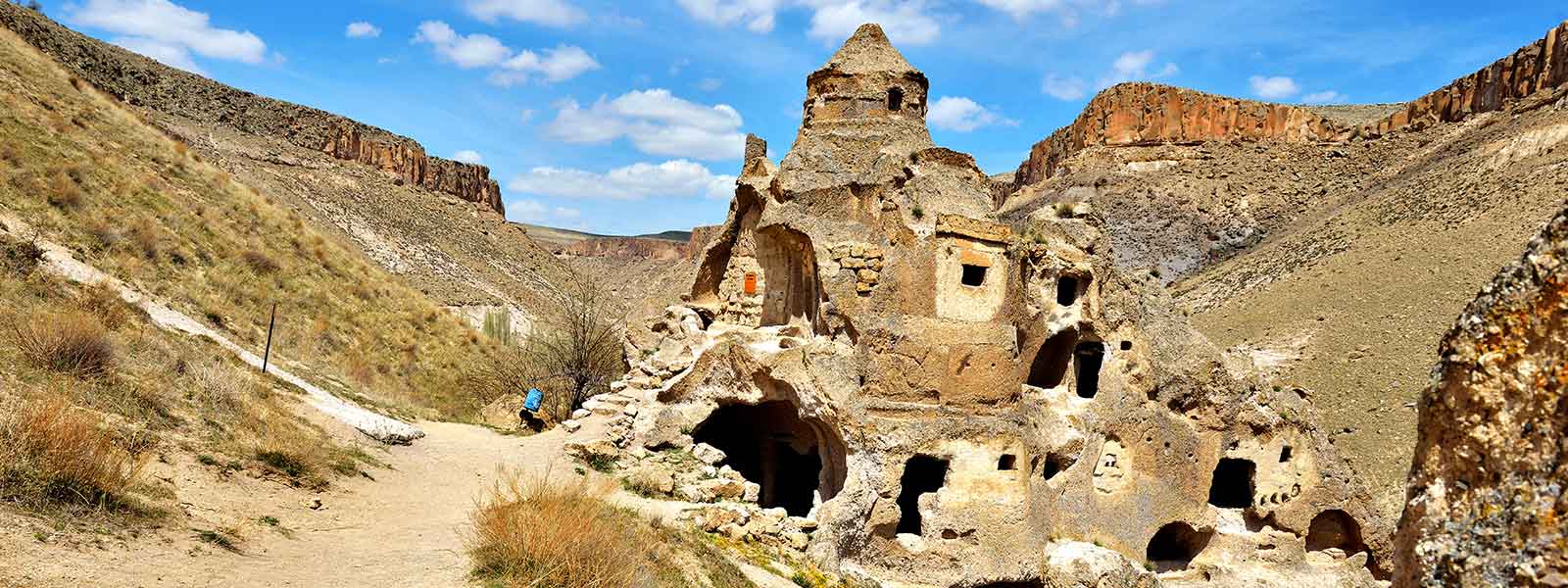
ANOTHER ANGLE OF CAPPADOCIA (SOGANLI VALLEY) TOUR
This tour will take you off the beaten track to the least crowded parts of South Cappadocia that we call Another Angle. Some of the almost untouched sites will carry you to the olden days; always peaceful, hospitable and impressively rich in Christian history.
Kaymakli Underground City is an amazing subterranean structure entirely carved out of volcanic rock, the beginning of which is uncertain but thought to have existed in the Hittite Age. It was used by the Christians in the 2nd and 3rd centuries during the Roman persecution and later in 8th to 10th centuries when Muslim Arab raiders were disturbing the area. It is one of the many underground cities in the region that would provide shelter in troubled times and additionally was a perfect storage area with its almost stable temperature throughout the year. A 10 km tunnel connects the city to the next one; Derinkuyu, probably many of them, had such connections to be used to escape the invaders. Inside, you will be surprised to see how it had been made possible to live for extended periods of time, weeks or months maybe, by means of personal quarters, air shafts, deep wells, barns, storage and cooking areas, and churches.
After the Kaymakli underground city visit; try to hear that a flute was blown in the far reaches of Cappadocia and echoed in the deserted valley of Soganli, one of the latest settlements of Christians in the area. It is a journey to the past; a pleasant walk among fairy chimney dwellings and rock-cut churches with still colorful frescoes mostly from the 6th century. You will visit the Karabas Kilisesi (Black Head Church) and Kubbeli Kilise (Domed Church) before you discover that the Hidden Church, Sakli Kilise is really hidden and you have no idea until you go closer. Yilanli Kilise (Serpent Church) is where you will see the only wall painting of Jesus Christ with white hair and then you take a break to have a look at the folkloric characteristics in the village.
Excited friendly local women will be displaying their handmade Soganli Dolls which was born about half a century ago when a grandmother made a rag doll to her granddaughter.



Taskinpasa Village is famous for its Medrese (Moslem School of Theology) from the Karamanid dynasty in the 14th century. It is an impressive example of classical Seljuk architecture with exquisite stone masonry. The portal which is decorated entirely with intricate geometrical and floral designs draws attention at first sight.
Keslik Monastery is a large complex within a lush green setting which is thought to be dating from 6th or 7th century; it was used during the Byzantine Age up until the end of Ottoman Empire in the 1920s. The complex has a large rock-cut refectory, living-sleeping quarters, a tunnel to escape from disturbing forces and a pool of sacred water. The Archangel Church is the most beautiful one in the monastery displaying frescoes about the life of the Virgin Mary and Jesus Christ. The Church of St Stephen, a short walk from the monastery, is from the 9th century, has got stunning frescoes which are out of the usual Cappadocian style with brilliant yellow and orange colors.
Cemil Village will give you the pleasure of being in an authentic small farming village where some of the inhabitants still live in caves. The stone church is the main attraction here, partially well-preserved decorations are dated 1916. The unusual frescoes on the pillars are also noteworthy in this rare architectural artifact. You will find the traditional way of life fascinating as you walk the old narrow streets.
Mustafapasa (Greek: Sinasos) is a town known to be Christian throughout the Seljuk and early Ottoman periods with a minor Muslim population. Greek inhabitants kept their culture alive throughout the centuries maintaining strong commercial relationships with Constantinople in the in the meantime. The Greek and Turkish Christians left the village with the population exchange between Turkey and Greece, and it was re-settled by the newcomers from the Balkans. There are a large number of beautifully decorated stone houses in the village that show the wealth and glamour of the old times. Some of them are open to visit so you can enjoy the gorgeous wall paintings inside and have Turkish tea or coffee to relax at the end of the day. Greek Orthodox Church of St. Helen and St. Constantine by the main square are notable for its elegant stone grapevine decoration on the portal. It was built in 1729 and restored in 1850.
You will also visit the small Church of St Stephen which was repaired in the early 20th century. A short walk away is the Monastery of St Nicholas which is accessed through an impressive stone gateway that was restored in 2012 together with the old gravestones in the courtyard. The outer wall of the main rock has decorations of Greek symbolism as well as motifs native to the region.
This South Cappadocia Tour can be combined with the arrival or departure Kayseri Airport transfers at reasonable touring hours.



